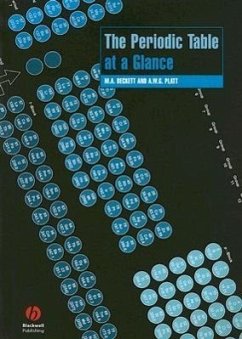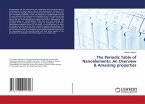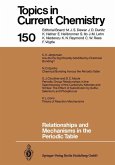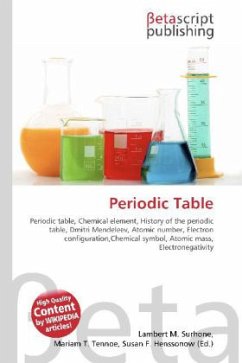- Broschiertes Buch
- Merkliste
- Auf die Merkliste
- Bewerten Bewerten
- Teilen
- Produkt teilen
- Produkterinnerung
- Produkterinnerung
Inorganic chemistry is a core part of the chemistry curricula, though it is often felt to be a huge range of disparate facts that have little underlying organization or reasoning. The periodic table was developed in the latter part of the 19th century, providing an organizing structure which began to explain the underlying principles of inorganic chemistry The Periodic Table at a Glance provides a concise overview of the main principles and reactions of inorganic chemistry, carefully structured around the periodic table, for students studying chemistry and related courses at undergraduate…mehr
Andere Kunden interessierten sich auch für
![THE NOVEL PERIODIC TABLE OF CHEMICAL CLUSTERS THE NOVEL PERIODIC TABLE OF CHEMICAL CLUSTERS]() Prof. Enos Masheija Rwantale KiremireTHE NOVEL PERIODIC TABLE OF CHEMICAL CLUSTERS57,99 €
Prof. Enos Masheija Rwantale KiremireTHE NOVEL PERIODIC TABLE OF CHEMICAL CLUSTERS57,99 €![PLAYFUL ACTIVITIES IN LEARNING THE PERIODIC CHEMICAL TABLE PLAYFUL ACTIVITIES IN LEARNING THE PERIODIC CHEMICAL TABLE]() Antônio Vitor MachadoPLAYFUL ACTIVITIES IN LEARNING THE PERIODIC CHEMICAL TABLE30,99 €
Antônio Vitor MachadoPLAYFUL ACTIVITIES IN LEARNING THE PERIODIC CHEMICAL TABLE30,99 €![The Periodic Table of Nanoelements: An Overview & Amaizing properties The Periodic Table of Nanoelements: An Overview & Amaizing properties]() Seham AlteraryThe Periodic Table of Nanoelements: An Overview & Amaizing properties47,99 €
Seham AlteraryThe Periodic Table of Nanoelements: An Overview & Amaizing properties47,99 €![Relationships and Mechanisms in the Periodic Table Relationships and Mechanisms in the Periodic Table]() Relationships and Mechanisms in the Periodic Table41,99 €
Relationships and Mechanisms in the Periodic Table41,99 €![NUMERICAL PERIODIC TABLE NUMERICAL PERIODIC TABLE]() Prof. Enos Masheija Rwantale KiremireNUMERICAL PERIODIC TABLE70,99 €
Prof. Enos Masheija Rwantale KiremireNUMERICAL PERIODIC TABLE70,99 €![Alternative periodic table using recycled paper Alternative periodic table using recycled paper]() Catiele Bruna Dell'OsbelAlternative periodic table using recycled paper25,99 €
Catiele Bruna Dell'OsbelAlternative periodic table using recycled paper25,99 €![Periodic Table Periodic Table]() Periodic Table27,99 €
Periodic Table27,99 €-
-
-
Inorganic chemistry is a core part of the chemistry curricula, though it is often felt to be a huge range of disparate facts that have little underlying organization or reasoning. The periodic table was developed in the latter part of the 19th century, providing an organizing structure which began to explain the underlying principles of inorganic chemistry The Periodic Table at a Glance provides a concise overview of the main principles and reactions of inorganic chemistry, carefully structured around the periodic table, for students studying chemistry and related courses at undergraduate level. Based on the highly successful and student friendly "at a glance" approach, the information is presented in integrated, self contained double page spreads of text and illustrative material, to facilitate the rapid assimilation, understanding and recall of critical concepts, facts and definitions. Students wanting a comprehensive and accessible overview of inorganic chemistry will find this book an ideal source of the information they require. In addition, the structured presentation will provide an invaluable aid to revision for students preparing for examinations.
Hinweis: Dieser Artikel kann nur an eine deutsche Lieferadresse ausgeliefert werden.
Hinweis: Dieser Artikel kann nur an eine deutsche Lieferadresse ausgeliefert werden.
Produktdetails
- Produktdetails
- Verlag: Wiley
- Seitenzahl: 128
- Altersempfehlung: 8 bis 12 Jahre
- Erscheinungstermin: 11. August 2006
- Englisch
- Abmessung: 296mm x 214mm x 8mm
- Gewicht: 408g
- ISBN-13: 9781405132992
- ISBN-10: 140513299X
- Artikelnr.: 21443754
- Herstellerkennzeichnung
- Libri GmbH
- Europaallee 1
- 36244 Bad Hersfeld
- gpsr@libri.de
- Verlag: Wiley
- Seitenzahl: 128
- Altersempfehlung: 8 bis 12 Jahre
- Erscheinungstermin: 11. August 2006
- Englisch
- Abmessung: 296mm x 214mm x 8mm
- Gewicht: 408g
- ISBN-13: 9781405132992
- ISBN-10: 140513299X
- Artikelnr.: 21443754
- Herstellerkennzeichnung
- Libri GmbH
- Europaallee 1
- 36244 Bad Hersfeld
- gpsr@libri.de
Michael Beckett is a Senior Lecturer in Inorganic Chemistry in the Chemistry Department, University of Wales, Bangor, UK. Andrew Platt is a Senior Lecturer in Forensic Science in the Faculty of Health and Sciences, Staffordshire University, UK
1. Atoms
The Periodic Table
And Periodic Properties. 1.1 Atomic Structure (I): introduction
electronic properties and wavefunctions. 1.2 Atomic Structure (II): quantum numbers
core and valence orbitals. 1.3 The Periodic Table: overview
atomic masses
the Periodic Table
historical perspective. 1.4 Periodic Properties: atomic
covalent and ionic radii
ionization energies
electron affinities
and electronegativities. 1.5 Redox Processes (I): standard reduction potentials
Latimer diagrams. 1.6 Redox Processes (II): Free Energy Oxidation STate (FROST) diagrams
construction of FROST diagrams
interpreting the FROST diagram. 2. Molecular Structures And Solid-State Giant Structures. 2.1 Covalent Interactions Between Atoms: overview
covalent bonding
Linear combination of atomic orbitals (LCAO)
hybridization
polarity of covalent bonds. 2.2 Shapes Of Molecules: Valence-Shell Electron-Pair Repulsion (VSEPR). 2.3 Structure and Bonding in Metals: structures
bonding
properties. 2.4 Ionic and Covalent Solid-State Giant Structures: ionic bonding
simple ionic crystals
cation/anion radius ratio rule
ion polarization
covalent giant structure. 3. s-Block Elements - Main Group Elements (Groups 1
2). 3.1 Group 1 Elements - The Alkali Metals (Li
Na
K
Rb
Cs
Fr): elements
reactivity of the elements
compounds
co-ordination complexes
flame test colours. 3.2 Group 2 Elements - The Alkaline Earths (Be
Mg
Ca
Sr
Ba
Ra): elements
reactivity of the elements
compounds
co-ordination complexes
flame test colours. 3.3 Some Industrial Processes Involving s-Block Elements: production and uses of salt
manufacture of caustic soda and the chloralkali industry
extraction of Na
soda ash
extraction of Mg. . 4. p-Block Elements - Main Group Elements (Groups 13-18). 4.1 General Overview Of p-Block Elements (I): introduction
electronic configurations
ionization energies
bonding. 4.2 General Overview Of p-Block elements (II): multiple bonds
molecular geometries. 4.3 Group 13 elements (B
Al
Ga
In
Tl): overview
halides
borates and aquo ions
co-ordination chemistry. 4.4 Borazene And The Boron Hydrides: borazene
boron hydrides. 4.5 Group 14 Elements (C
Si
Ge
Sn
Pb): overview
hydrides
multiple bonds
halides
oxides. 4.6 Silicate And Siloxane Chemistry: water glass solutions
solid-state silicate anions
zeolite chemistry
siloxanes. 4.7 Group 15 Elements - The Pnicogens (N
P
As
Sb
Bi): hydrides
halides
oxides
oxyanions
polyphosphazenes. 4.8 Group 16 Elements - The Chalcogens (O
S
Se
Te
Po): oxidation states
hydrides
halides
Lewis acid/Lewis base behaviour. 4.9 Sulphur And Its Compounds (I): minerals and production
allotropes
hydrides and sulphide anions
oxides. 4.10 Sulphur And Its Compounds(II): oxyanions and related compounds
redox chemistry
sulphur-nitrogen chemistry. 4.11 Group 17 Elements -The Halogens (F
Cl
Br
I
At): overview
oxidation states
interhalogen compounds
polyhalides
donor properties of halide anions. 4.12 Group 18 Elements - The 'Inert' Gases (He
Ne
Ar
Kr
Xe
Rn): introduction
xenon fluorides
xenon oxygen compounds
compounds with bonds between xenon and other elements
krypton compounds
compounds of radon and argon. 4.13 Some Industrial Processes Involving p-Block Elements (I): Al production
alkene polymerization
bromine. 4.14 Some Industrial Processes Involving p-Block Elements (II): ammonia
nitric acid. 5. Hydrogen. 5.1 Hydrogen - The First Element: occurrence
atomic structure
physical properties of the element
H2 as an industrial chemical
position in the Periodic Table. 5.2 Hydrogen - Chemical Properties: introduction
saline hydrides
covalent hydrides
hydrogen bonds
Bronsted acidity and H+
metallic hydrides. . 6. d-Block Elements - Transition metals (Groups 3-12). 6.1 Electronic Configurations And General Reactivity: characteristic properties of the d-block elements
electronic configurations
physical properties and general reactivity. 6.2 An Overview Of Chemical And Physical Properties Of The d-Block Elements: co-ordination compounds (formation of complexes)
coloured compounds
paramagnetism
catalysis by d-block metals. 6.2 Variable Oxidation States: First transition (3d) series
Group 5 - oxidation states of V
Group 6 - oxidation states of Cr
Group 7 - oxidation states of Mn
oxidation states of the second (4d) and third (5d) transition series. 6.4 Co-ordination Compounds (I): ligands and denticity
co-ordination numbers and co-ordination geometries
the chelate effect. 6.5 Co-ordination Compounds (II): kinetically inert and labile complexes
stepwise and overall stability constants
Irving Williams series for M2+
the effect of metal charge on stability constants
substitution in square-planar Pt(II) complexes. 6.6 Isomerism In Co-ordination Compounds: isomerism
geometrical isomerism
optical isomerism
ionization isomerism
linkage isomerism
co-ordination isomerism. 6.7 Reactions Of Transition Metal Aquo Ions: solution structure of aquo ions
reactivity of aquo ions (redox
acidity
substitution). 6.8 Crystal Field And Ligand field Theory: introduction
octahedral
square-planar
tetrahedral complexes
Jahn-Teller effect. 6.9 Ligand Field Theory And Electronic Spectra (Colours) Of Transition Metal Complexes: colours of transition metal complexes
factors which effect the magnitude of D. 6.10 Ligand Field Theory And Magnetic Properties: overview
magnetic susceptibilty
high spin/low spin complexes
ferromagnetism. 6.11 Metal Carbonyl Chemistry: organometallic compounds
the 18- rule
structures of binary metal carbonyls
substitution mechanisms. 6.12 d-Block Elements And Industrial Chemistry: production of Fe and steel
production of TiO2
purification of Ni
homogeneous catalysis
heterogeneous catalysis. . 7. f-Block Elements - Lanthanides and Actinides. 7.1 The 4f Elements - The Lanthanides or Rare Earths: introduction
electronic configuration
lanthanide contraction
oxidation states (+3
+2 and +4)
typical chemistry. 7.2 The 5f Elements - The Actinides: occurrence
electronic configuration
typical chemistry. 7.3 Some Applications Of The f-Block Elements: lanthanides (medical imaging
catalytic converters)
actinides (nuclear fuels
smoke detectors).
The Periodic Table
And Periodic Properties. 1.1 Atomic Structure (I): introduction
electronic properties and wavefunctions. 1.2 Atomic Structure (II): quantum numbers
core and valence orbitals. 1.3 The Periodic Table: overview
atomic masses
the Periodic Table
historical perspective. 1.4 Periodic Properties: atomic
covalent and ionic radii
ionization energies
electron affinities
and electronegativities. 1.5 Redox Processes (I): standard reduction potentials
Latimer diagrams. 1.6 Redox Processes (II): Free Energy Oxidation STate (FROST) diagrams
construction of FROST diagrams
interpreting the FROST diagram. 2. Molecular Structures And Solid-State Giant Structures. 2.1 Covalent Interactions Between Atoms: overview
covalent bonding
Linear combination of atomic orbitals (LCAO)
hybridization
polarity of covalent bonds. 2.2 Shapes Of Molecules: Valence-Shell Electron-Pair Repulsion (VSEPR). 2.3 Structure and Bonding in Metals: structures
bonding
properties. 2.4 Ionic and Covalent Solid-State Giant Structures: ionic bonding
simple ionic crystals
cation/anion radius ratio rule
ion polarization
covalent giant structure. 3. s-Block Elements - Main Group Elements (Groups 1
2). 3.1 Group 1 Elements - The Alkali Metals (Li
Na
K
Rb
Cs
Fr): elements
reactivity of the elements
compounds
co-ordination complexes
flame test colours. 3.2 Group 2 Elements - The Alkaline Earths (Be
Mg
Ca
Sr
Ba
Ra): elements
reactivity of the elements
compounds
co-ordination complexes
flame test colours. 3.3 Some Industrial Processes Involving s-Block Elements: production and uses of salt
manufacture of caustic soda and the chloralkali industry
extraction of Na
soda ash
extraction of Mg. . 4. p-Block Elements - Main Group Elements (Groups 13-18). 4.1 General Overview Of p-Block Elements (I): introduction
electronic configurations
ionization energies
bonding. 4.2 General Overview Of p-Block elements (II): multiple bonds
molecular geometries. 4.3 Group 13 elements (B
Al
Ga
In
Tl): overview
halides
borates and aquo ions
co-ordination chemistry. 4.4 Borazene And The Boron Hydrides: borazene
boron hydrides. 4.5 Group 14 Elements (C
Si
Ge
Sn
Pb): overview
hydrides
multiple bonds
halides
oxides. 4.6 Silicate And Siloxane Chemistry: water glass solutions
solid-state silicate anions
zeolite chemistry
siloxanes. 4.7 Group 15 Elements - The Pnicogens (N
P
As
Sb
Bi): hydrides
halides
oxides
oxyanions
polyphosphazenes. 4.8 Group 16 Elements - The Chalcogens (O
S
Se
Te
Po): oxidation states
hydrides
halides
Lewis acid/Lewis base behaviour. 4.9 Sulphur And Its Compounds (I): minerals and production
allotropes
hydrides and sulphide anions
oxides. 4.10 Sulphur And Its Compounds(II): oxyanions and related compounds
redox chemistry
sulphur-nitrogen chemistry. 4.11 Group 17 Elements -The Halogens (F
Cl
Br
I
At): overview
oxidation states
interhalogen compounds
polyhalides
donor properties of halide anions. 4.12 Group 18 Elements - The 'Inert' Gases (He
Ne
Ar
Kr
Xe
Rn): introduction
xenon fluorides
xenon oxygen compounds
compounds with bonds between xenon and other elements
krypton compounds
compounds of radon and argon. 4.13 Some Industrial Processes Involving p-Block Elements (I): Al production
alkene polymerization
bromine. 4.14 Some Industrial Processes Involving p-Block Elements (II): ammonia
nitric acid. 5. Hydrogen. 5.1 Hydrogen - The First Element: occurrence
atomic structure
physical properties of the element
H2 as an industrial chemical
position in the Periodic Table. 5.2 Hydrogen - Chemical Properties: introduction
saline hydrides
covalent hydrides
hydrogen bonds
Bronsted acidity and H+
metallic hydrides. . 6. d-Block Elements - Transition metals (Groups 3-12). 6.1 Electronic Configurations And General Reactivity: characteristic properties of the d-block elements
electronic configurations
physical properties and general reactivity. 6.2 An Overview Of Chemical And Physical Properties Of The d-Block Elements: co-ordination compounds (formation of complexes)
coloured compounds
paramagnetism
catalysis by d-block metals. 6.2 Variable Oxidation States: First transition (3d) series
Group 5 - oxidation states of V
Group 6 - oxidation states of Cr
Group 7 - oxidation states of Mn
oxidation states of the second (4d) and third (5d) transition series. 6.4 Co-ordination Compounds (I): ligands and denticity
co-ordination numbers and co-ordination geometries
the chelate effect. 6.5 Co-ordination Compounds (II): kinetically inert and labile complexes
stepwise and overall stability constants
Irving Williams series for M2+
the effect of metal charge on stability constants
substitution in square-planar Pt(II) complexes. 6.6 Isomerism In Co-ordination Compounds: isomerism
geometrical isomerism
optical isomerism
ionization isomerism
linkage isomerism
co-ordination isomerism. 6.7 Reactions Of Transition Metal Aquo Ions: solution structure of aquo ions
reactivity of aquo ions (redox
acidity
substitution). 6.8 Crystal Field And Ligand field Theory: introduction
octahedral
square-planar
tetrahedral complexes
Jahn-Teller effect. 6.9 Ligand Field Theory And Electronic Spectra (Colours) Of Transition Metal Complexes: colours of transition metal complexes
factors which effect the magnitude of D. 6.10 Ligand Field Theory And Magnetic Properties: overview
magnetic susceptibilty
high spin/low spin complexes
ferromagnetism. 6.11 Metal Carbonyl Chemistry: organometallic compounds
the 18- rule
structures of binary metal carbonyls
substitution mechanisms. 6.12 d-Block Elements And Industrial Chemistry: production of Fe and steel
production of TiO2
purification of Ni
homogeneous catalysis
heterogeneous catalysis. . 7. f-Block Elements - Lanthanides and Actinides. 7.1 The 4f Elements - The Lanthanides or Rare Earths: introduction
electronic configuration
lanthanide contraction
oxidation states (+3
+2 and +4)
typical chemistry. 7.2 The 5f Elements - The Actinides: occurrence
electronic configuration
typical chemistry. 7.3 Some Applications Of The f-Block Elements: lanthanides (medical imaging
catalytic converters)
actinides (nuclear fuels
smoke detectors).
1. Atoms
The Periodic Table
And Periodic Properties. 1.1 Atomic Structure (I): introduction
electronic properties and wavefunctions. 1.2 Atomic Structure (II): quantum numbers
core and valence orbitals. 1.3 The Periodic Table: overview
atomic masses
the Periodic Table
historical perspective. 1.4 Periodic Properties: atomic
covalent and ionic radii
ionization energies
electron affinities
and electronegativities. 1.5 Redox Processes (I): standard reduction potentials
Latimer diagrams. 1.6 Redox Processes (II): Free Energy Oxidation STate (FROST) diagrams
construction of FROST diagrams
interpreting the FROST diagram. 2. Molecular Structures And Solid-State Giant Structures. 2.1 Covalent Interactions Between Atoms: overview
covalent bonding
Linear combination of atomic orbitals (LCAO)
hybridization
polarity of covalent bonds. 2.2 Shapes Of Molecules: Valence-Shell Electron-Pair Repulsion (VSEPR). 2.3 Structure and Bonding in Metals: structures
bonding
properties. 2.4 Ionic and Covalent Solid-State Giant Structures: ionic bonding
simple ionic crystals
cation/anion radius ratio rule
ion polarization
covalent giant structure. 3. s-Block Elements - Main Group Elements (Groups 1
2). 3.1 Group 1 Elements - The Alkali Metals (Li
Na
K
Rb
Cs
Fr): elements
reactivity of the elements
compounds
co-ordination complexes
flame test colours. 3.2 Group 2 Elements - The Alkaline Earths (Be
Mg
Ca
Sr
Ba
Ra): elements
reactivity of the elements
compounds
co-ordination complexes
flame test colours. 3.3 Some Industrial Processes Involving s-Block Elements: production and uses of salt
manufacture of caustic soda and the chloralkali industry
extraction of Na
soda ash
extraction of Mg. . 4. p-Block Elements - Main Group Elements (Groups 13-18). 4.1 General Overview Of p-Block Elements (I): introduction
electronic configurations
ionization energies
bonding. 4.2 General Overview Of p-Block elements (II): multiple bonds
molecular geometries. 4.3 Group 13 elements (B
Al
Ga
In
Tl): overview
halides
borates and aquo ions
co-ordination chemistry. 4.4 Borazene And The Boron Hydrides: borazene
boron hydrides. 4.5 Group 14 Elements (C
Si
Ge
Sn
Pb): overview
hydrides
multiple bonds
halides
oxides. 4.6 Silicate And Siloxane Chemistry: water glass solutions
solid-state silicate anions
zeolite chemistry
siloxanes. 4.7 Group 15 Elements - The Pnicogens (N
P
As
Sb
Bi): hydrides
halides
oxides
oxyanions
polyphosphazenes. 4.8 Group 16 Elements - The Chalcogens (O
S
Se
Te
Po): oxidation states
hydrides
halides
Lewis acid/Lewis base behaviour. 4.9 Sulphur And Its Compounds (I): minerals and production
allotropes
hydrides and sulphide anions
oxides. 4.10 Sulphur And Its Compounds(II): oxyanions and related compounds
redox chemistry
sulphur-nitrogen chemistry. 4.11 Group 17 Elements -The Halogens (F
Cl
Br
I
At): overview
oxidation states
interhalogen compounds
polyhalides
donor properties of halide anions. 4.12 Group 18 Elements - The 'Inert' Gases (He
Ne
Ar
Kr
Xe
Rn): introduction
xenon fluorides
xenon oxygen compounds
compounds with bonds between xenon and other elements
krypton compounds
compounds of radon and argon. 4.13 Some Industrial Processes Involving p-Block Elements (I): Al production
alkene polymerization
bromine. 4.14 Some Industrial Processes Involving p-Block Elements (II): ammonia
nitric acid. 5. Hydrogen. 5.1 Hydrogen - The First Element: occurrence
atomic structure
physical properties of the element
H2 as an industrial chemical
position in the Periodic Table. 5.2 Hydrogen - Chemical Properties: introduction
saline hydrides
covalent hydrides
hydrogen bonds
Bronsted acidity and H+
metallic hydrides. . 6. d-Block Elements - Transition metals (Groups 3-12). 6.1 Electronic Configurations And General Reactivity: characteristic properties of the d-block elements
electronic configurations
physical properties and general reactivity. 6.2 An Overview Of Chemical And Physical Properties Of The d-Block Elements: co-ordination compounds (formation of complexes)
coloured compounds
paramagnetism
catalysis by d-block metals. 6.2 Variable Oxidation States: First transition (3d) series
Group 5 - oxidation states of V
Group 6 - oxidation states of Cr
Group 7 - oxidation states of Mn
oxidation states of the second (4d) and third (5d) transition series. 6.4 Co-ordination Compounds (I): ligands and denticity
co-ordination numbers and co-ordination geometries
the chelate effect. 6.5 Co-ordination Compounds (II): kinetically inert and labile complexes
stepwise and overall stability constants
Irving Williams series for M2+
the effect of metal charge on stability constants
substitution in square-planar Pt(II) complexes. 6.6 Isomerism In Co-ordination Compounds: isomerism
geometrical isomerism
optical isomerism
ionization isomerism
linkage isomerism
co-ordination isomerism. 6.7 Reactions Of Transition Metal Aquo Ions: solution structure of aquo ions
reactivity of aquo ions (redox
acidity
substitution). 6.8 Crystal Field And Ligand field Theory: introduction
octahedral
square-planar
tetrahedral complexes
Jahn-Teller effect. 6.9 Ligand Field Theory And Electronic Spectra (Colours) Of Transition Metal Complexes: colours of transition metal complexes
factors which effect the magnitude of D. 6.10 Ligand Field Theory And Magnetic Properties: overview
magnetic susceptibilty
high spin/low spin complexes
ferromagnetism. 6.11 Metal Carbonyl Chemistry: organometallic compounds
the 18- rule
structures of binary metal carbonyls
substitution mechanisms. 6.12 d-Block Elements And Industrial Chemistry: production of Fe and steel
production of TiO2
purification of Ni
homogeneous catalysis
heterogeneous catalysis. . 7. f-Block Elements - Lanthanides and Actinides. 7.1 The 4f Elements - The Lanthanides or Rare Earths: introduction
electronic configuration
lanthanide contraction
oxidation states (+3
+2 and +4)
typical chemistry. 7.2 The 5f Elements - The Actinides: occurrence
electronic configuration
typical chemistry. 7.3 Some Applications Of The f-Block Elements: lanthanides (medical imaging
catalytic converters)
actinides (nuclear fuels
smoke detectors).
The Periodic Table
And Periodic Properties. 1.1 Atomic Structure (I): introduction
electronic properties and wavefunctions. 1.2 Atomic Structure (II): quantum numbers
core and valence orbitals. 1.3 The Periodic Table: overview
atomic masses
the Periodic Table
historical perspective. 1.4 Periodic Properties: atomic
covalent and ionic radii
ionization energies
electron affinities
and electronegativities. 1.5 Redox Processes (I): standard reduction potentials
Latimer diagrams. 1.6 Redox Processes (II): Free Energy Oxidation STate (FROST) diagrams
construction of FROST diagrams
interpreting the FROST diagram. 2. Molecular Structures And Solid-State Giant Structures. 2.1 Covalent Interactions Between Atoms: overview
covalent bonding
Linear combination of atomic orbitals (LCAO)
hybridization
polarity of covalent bonds. 2.2 Shapes Of Molecules: Valence-Shell Electron-Pair Repulsion (VSEPR). 2.3 Structure and Bonding in Metals: structures
bonding
properties. 2.4 Ionic and Covalent Solid-State Giant Structures: ionic bonding
simple ionic crystals
cation/anion radius ratio rule
ion polarization
covalent giant structure. 3. s-Block Elements - Main Group Elements (Groups 1
2). 3.1 Group 1 Elements - The Alkali Metals (Li
Na
K
Rb
Cs
Fr): elements
reactivity of the elements
compounds
co-ordination complexes
flame test colours. 3.2 Group 2 Elements - The Alkaline Earths (Be
Mg
Ca
Sr
Ba
Ra): elements
reactivity of the elements
compounds
co-ordination complexes
flame test colours. 3.3 Some Industrial Processes Involving s-Block Elements: production and uses of salt
manufacture of caustic soda and the chloralkali industry
extraction of Na
soda ash
extraction of Mg. . 4. p-Block Elements - Main Group Elements (Groups 13-18). 4.1 General Overview Of p-Block Elements (I): introduction
electronic configurations
ionization energies
bonding. 4.2 General Overview Of p-Block elements (II): multiple bonds
molecular geometries. 4.3 Group 13 elements (B
Al
Ga
In
Tl): overview
halides
borates and aquo ions
co-ordination chemistry. 4.4 Borazene And The Boron Hydrides: borazene
boron hydrides. 4.5 Group 14 Elements (C
Si
Ge
Sn
Pb): overview
hydrides
multiple bonds
halides
oxides. 4.6 Silicate And Siloxane Chemistry: water glass solutions
solid-state silicate anions
zeolite chemistry
siloxanes. 4.7 Group 15 Elements - The Pnicogens (N
P
As
Sb
Bi): hydrides
halides
oxides
oxyanions
polyphosphazenes. 4.8 Group 16 Elements - The Chalcogens (O
S
Se
Te
Po): oxidation states
hydrides
halides
Lewis acid/Lewis base behaviour. 4.9 Sulphur And Its Compounds (I): minerals and production
allotropes
hydrides and sulphide anions
oxides. 4.10 Sulphur And Its Compounds(II): oxyanions and related compounds
redox chemistry
sulphur-nitrogen chemistry. 4.11 Group 17 Elements -The Halogens (F
Cl
Br
I
At): overview
oxidation states
interhalogen compounds
polyhalides
donor properties of halide anions. 4.12 Group 18 Elements - The 'Inert' Gases (He
Ne
Ar
Kr
Xe
Rn): introduction
xenon fluorides
xenon oxygen compounds
compounds with bonds between xenon and other elements
krypton compounds
compounds of radon and argon. 4.13 Some Industrial Processes Involving p-Block Elements (I): Al production
alkene polymerization
bromine. 4.14 Some Industrial Processes Involving p-Block Elements (II): ammonia
nitric acid. 5. Hydrogen. 5.1 Hydrogen - The First Element: occurrence
atomic structure
physical properties of the element
H2 as an industrial chemical
position in the Periodic Table. 5.2 Hydrogen - Chemical Properties: introduction
saline hydrides
covalent hydrides
hydrogen bonds
Bronsted acidity and H+
metallic hydrides. . 6. d-Block Elements - Transition metals (Groups 3-12). 6.1 Electronic Configurations And General Reactivity: characteristic properties of the d-block elements
electronic configurations
physical properties and general reactivity. 6.2 An Overview Of Chemical And Physical Properties Of The d-Block Elements: co-ordination compounds (formation of complexes)
coloured compounds
paramagnetism
catalysis by d-block metals. 6.2 Variable Oxidation States: First transition (3d) series
Group 5 - oxidation states of V
Group 6 - oxidation states of Cr
Group 7 - oxidation states of Mn
oxidation states of the second (4d) and third (5d) transition series. 6.4 Co-ordination Compounds (I): ligands and denticity
co-ordination numbers and co-ordination geometries
the chelate effect. 6.5 Co-ordination Compounds (II): kinetically inert and labile complexes
stepwise and overall stability constants
Irving Williams series for M2+
the effect of metal charge on stability constants
substitution in square-planar Pt(II) complexes. 6.6 Isomerism In Co-ordination Compounds: isomerism
geometrical isomerism
optical isomerism
ionization isomerism
linkage isomerism
co-ordination isomerism. 6.7 Reactions Of Transition Metal Aquo Ions: solution structure of aquo ions
reactivity of aquo ions (redox
acidity
substitution). 6.8 Crystal Field And Ligand field Theory: introduction
octahedral
square-planar
tetrahedral complexes
Jahn-Teller effect. 6.9 Ligand Field Theory And Electronic Spectra (Colours) Of Transition Metal Complexes: colours of transition metal complexes
factors which effect the magnitude of D. 6.10 Ligand Field Theory And Magnetic Properties: overview
magnetic susceptibilty
high spin/low spin complexes
ferromagnetism. 6.11 Metal Carbonyl Chemistry: organometallic compounds
the 18- rule
structures of binary metal carbonyls
substitution mechanisms. 6.12 d-Block Elements And Industrial Chemistry: production of Fe and steel
production of TiO2
purification of Ni
homogeneous catalysis
heterogeneous catalysis. . 7. f-Block Elements - Lanthanides and Actinides. 7.1 The 4f Elements - The Lanthanides or Rare Earths: introduction
electronic configuration
lanthanide contraction
oxidation states (+3
+2 and +4)
typical chemistry. 7.2 The 5f Elements - The Actinides: occurrence
electronic configuration
typical chemistry. 7.3 Some Applications Of The f-Block Elements: lanthanides (medical imaging
catalytic converters)
actinides (nuclear fuels
smoke detectors).








